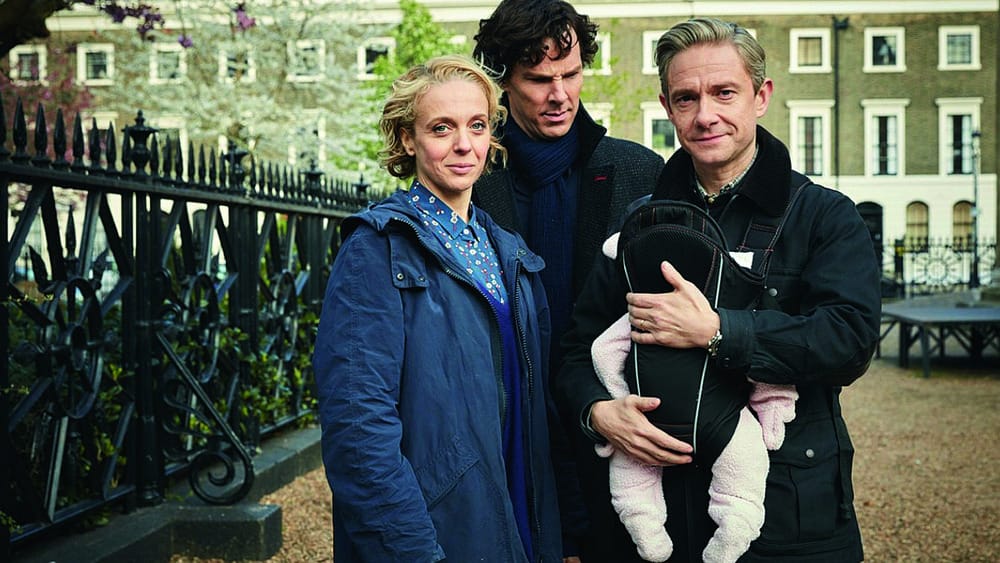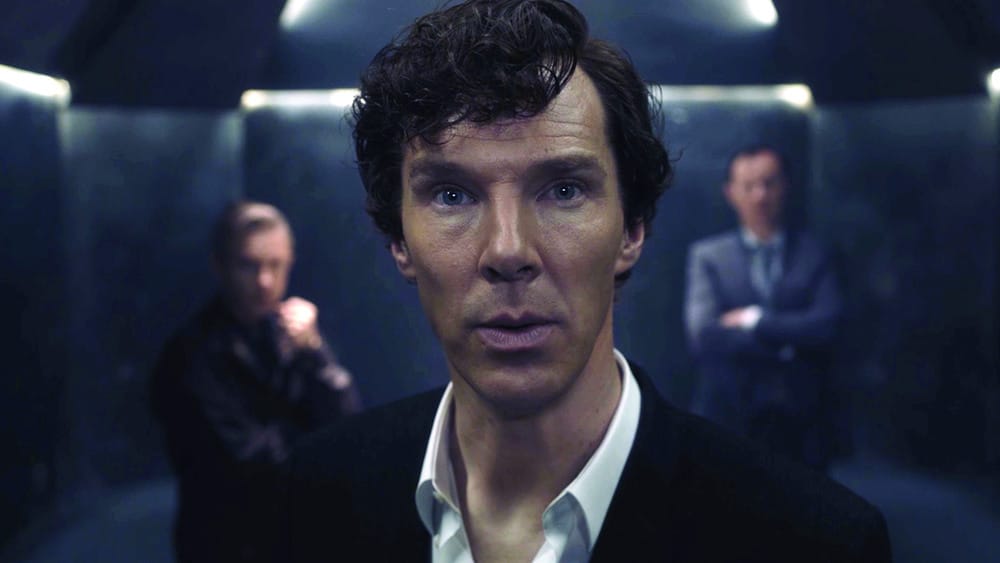A series of final problems | Sherlock
The hair’s looking better this season, at least

In 2010 when Sherlock was first introduced to the world as Arthur Conan Doyle’s great detective being brought into the 21st century, co-creator Steven Moffat explained his motivations in making the series to Premium Hollywood thus: “This wasn’t a case of, ‘Let’s grab that off the shelf and update it.’ It was, ‘We love this, we think everybody’s been getting it wrong, and we think we can get it right.’ Unless you think you’re correcting everyone else, you shouldn’t be doing something. You should be saying, ‘Now this is the way it should be done.’ “ Admirable words, certainly but it does beg the question: what exactly did Moffat and co-creator Mark Gatiss think should be done?
The Final Problem, which could very well be the last ever episode of Sherlock given the demand for stars Benedict Cumberbatch and Martin Freeman seemed at points to be playing a game of “bad screenwriting” bingo – checking off one contrivance after the other. The Sherlock Holmes canon is known above all for its grounding in rational thought; that Holmes should remain the ideal of the triumph of reasoning over the mystical, substance over style was a conviction that Conan Doyle stuck doggedly to even though he was intrigued by the possibility of the supernatural in his life. Gatiss and Moffat’s Sherlock in its seven year run was known for honouring this tradition even as the writers adapted and re-formed the original stories for the episodes. The Final Problem however chose to dive head first into the world of the impossible in a move that made watching the episode feel like being suspended in a constant state of anticipation – waiting for the other shoe to drop – waiting for Sherlock to wake up, waiting for everything to be explained.
From the first moments we are plunged into a world populated with killer clowns, portraits that cry blood, men who can jump from burning second storey flats onto busy London streets and walk away unharmed, we are asked to believe that a secret omnipotent Holmes sister lives in an Azkaban-like prison fortress plotting revenge for the time her infant brother didn’t play with her (despite her mind control abilities). We are asked to believe in a detective who walks into a brightly lit room and cannot distinguish glass from empty air, we are asked to believe that Mary Watson, before her entirely unplanned death, recorded several DVD messages and arranged for them to be delivered to her husband and to his best friend to aid them in their emotional journey from the grave. We were asked to believe a child turned the memory of his murdered best friend into the memory of a dog. We were, in short, asked to believe too much, suspend our disbelief for too long. Sherlock was once a show built on ingenuity – plot twists that were surprising but could be predicted if one looked hard at the clues, it was a show that invited the audience to deduce it, yet here, in its last hurrah, it gave up intelligent dramatization and character development for a remake of Saw.

The problems with The Final Problem are the ones that have steadily accumulated throughout Series 4 which progressively became detached from any semblance of reality. Chekov’s gun’ is the principle that once a gun has been placed on the stage, the rules of fiction demand the trigger to be pulled. In Series 4 in general, and The Final Problem in particular, Sherlock threw gun after gun (both metaphorical and literal) onto the screen and allowed its characters to waltz through them as if they were wisps of smoke. Gone was the cerebral, carefully constructed show that we were first introduced to in 2010, in its stead was a show that introduced intriguing developments only to abandon them. What was the recurring dream Sherlock talked to his therapist about in The Six Thatchers? Where was the development from the “romantic entanglement, while fulfilling for other people – would complete you as a human being” exchange between Sherlock and John in The Lying Detective? Surely not with Molly - the “I love you” that was so widely publicised before the series aired turned out to be part of a horrifically misogynistic and manipulative scene, the emotional fallout from which was never explored. The Final Problem revelled in its hollowness, watching it felt like being trapped inside a cardboard bunker - as indeed Sherlock was in the last scenes of the episode - the walls of the world The Final Problem created collapsed at the slightest scrutiny. “No loose ends, not on my watch” proclaimed Mark Gatiss as Mycroft Holmes in the second episode of this series – one could’ve drowned in the loose ends in the episode that followed.
If this is indeed the last episode of Sherlock, how will the series be judged as a whole? The subject of queer-baiting is likely to be one of the most associated. Sherlock is a show that delved again and again into the idea of Sherlock Holmes’ repressed romantic life; characters within the show mistake Sherlock and John for a couple across episodes and series – these assumptions are met with flustered denial from John and pointed silence from Sherlock. Benedict Cumberbatch delivered a masterful performance of a man devastated by the marriage of the man he loves to someone else in The Sign of Three. The seeds of the idea that the Sherlock and John relationship could develop into a romantic one were steadily planted never to fully flourish. Subtextually the show referred heavily to The Private Life of Sherlock Holmes, a film that both Gatiss and Moffat rate as one of their favourite adaptations of the original stories – Gatiss going so far as to say to The Guardian that the screenplay formed a template for BBC’s Sherlock. In Private Life, Sherlock Holmes is depicted as a closeted gay man desperately, silently in love with John Watson, medicating with cocaine to hide his pain and guilt. Years after the film’s release, director Billy Wilder spoke of his great regret of never making the relationship explicit “I wanted to make Holmes a homosexual . . . That’s why he’s on dope, you know.” Wilder is a character that appears in The Abominable Bride: the skull in 221B, Sherlock’s junkie friend, even Sherlock himself (“William Sherlock Scott Holmes- if you’re looking for baby names”) are all named “Billy”, and numerous lines from “is tea code?” to “admirably high arches”, to the flower in John’s hair are Private Life references. Yet all this queer coding – nudges at Oscar Wilde, at Private Life, all those aborted almost confessions – at the tarmac, at the end of The Lying Detective come to nothing, or are treated as a joke. The villains on the other hand – from Moriarty, to Irene Adler to Euros are explicitly stated to be queer. Their queerness is often associated with violence or sexual abuse (Moriarty and Euros) or disregarded altogether in service of plot (Irene). Such blatant homophobia is always unacceptable but especially galling from Mark Gatiss, himself a gay man.

In an interview with Gay Times in 2011 Gatiss spoke of his dream of intelligently portrayed queer representation on TV; “That’s how the revolution happens... I think when the day comes that you have a big detective show… [in which the detective goes to work and] he’s a maverick and all the usual things and [when he gets home] and his boyfriend says, “Are you alright?”... then something would have genuinely changed.” On Sherlock, Gatiss was given the chance to stage that revolution and it would seem he had neither the courage nor the ingenuity to seize it. Moffat has long been accused of misogynistic writing and the accusations follow him to Sherlock. Mary, the unseen housewife who dies off screen in the Conan Doyle stories was transformed into a character with agency in the BBC show only to die on screen and be periodically resurrected to help her “Baker Street boys” along. It was a textbook case of ‘fridging’ a female character – an allusion heightened by Mycroft opening an empty fridge in the moments after Mary’s death. Molly, a Gatiss and Moffat original character grew to develop beyond her infatuation with Sherlock through the series only to be forced back into that box in the final episode. These instances only add to the already long list of crimes this show has perpetrated against its female characters throughout its run.
Real world implications aside, in a purely narrative sense The Final Problem and Series 4 as a whole set about systematically dismantling what the previous three seasons built up. In an interview with IGN in 2014 Steven Moffat said of the show: “ it’s not a detective show. It’s a show about a detective. That’s why it’s exciting.” Yet in a voice over at the end of The Final Problem Mary declares “it not about who you really are, it’s all about the legends.” The show sacrificed character growth at the altar of high octane action and as a result fell utterly flat, becoming a parody of itself and its genre. Indeed the final episode’s incongruity with the show as a whole has led some fans to speculate on the existence of a secret fourth episode that is yet to air – and who can blame them, from the first moment of The Final Problem to its last it feels like Moriarty has hacked into every screen showing Sherlock.
If this final episode really is the end of series 4 (and at this point it’s far from certainty in my mind) then it was the protracted death of a once great show. The show runners doubt whether they will be able to make series 5; if this is was the culmination of their great plan, they don’t deserve to. The Final Problem got a standing ovation at the press screening. Why, we must ask ourselves. Perhaps, as one incisive friend put it, it was because it was finally, thankfully, over.









